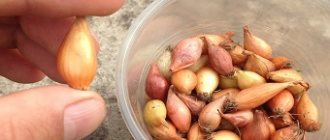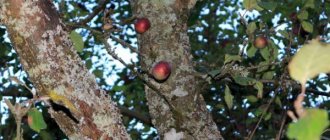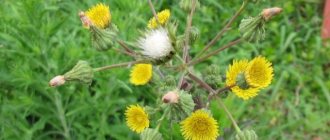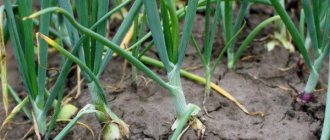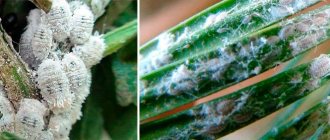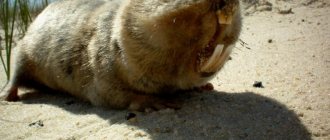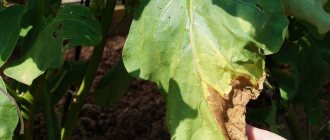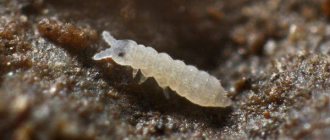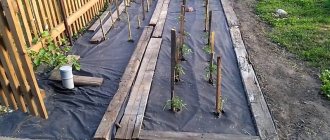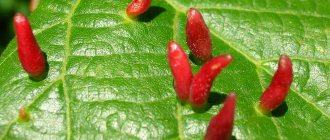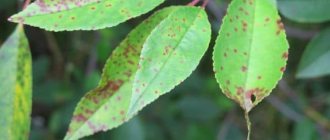Glassworm on currants leads to the destruction of the crop. Insects appear suddenly and quickly take over new territories. The bush begins to wither and then dries out completely. It is necessary to take effective measures to combat the pest in spring and autumn, then the glassweed can be defeated and the crop can be kept healthy. Getting rid of it is not so easy; you need to know how and when to process the branches.
What does the pest look like, signs of appearance on plants
First, let's figure out what the pest itself looks like.
The adult insect resembles a wasp with its black and yellow coloration. It has a more monolithic body. The wasp has a pronounced waist, while the glass beetle does not.
,
The wings of the insect have a clearly noticeable orange-brown tint. In addition, the glass is rather black with yellow stripes. He also has a long black mustache.
The caterpillar is small (about 2 cm), yellowish-gray in color and has a red-brown head. It is very difficult to detect, since it lives in the core of the currant branch.
ON A NOTE. After itself, the caterpillar leaves a channel along the entire length of the shoot.
It is very, very difficult to determine invasion in the early stages. The fact is that outwardly a diseased bush is no different from healthy ones.
Only over time do the infected branches begin to show signs of the presence of glassworm. Namely: withering of foliage, drying of branches, stunting of growth, decreased yield.
Preventive methods
Since it is difficult to control the pest, experienced gardeners recommend taking all possible measures to prevent its appearance on currants. For prevention purposes, it is recommended:
- Reject damaged petioles (with dead buds, dark holes in the middle of the cut).
- Every year, with the onset of warm weather, thin out the bushes, cut off branches that lie on the ground, as well as shoots damaged by pests.
- Systematically inspect the plants and, if necessary, remove dried branches.
- Trim and burn dead branches in the fall. Treat cut areas with disinfectants - special pastes or garden varnish, which is prepared from rosin (3 parts), paraffin (6 parts) and vegetable oil (2 parts). Instead of vegetable oil, you can use mineral oil, interior fat or 1 part of natural drying oil.
Timely identification and elimination of pests on currants helps prevent a decrease in yield and keep the plant strong and healthy. Ignoring the symptoms of glassworm damage leads to the death of the plant. In case of mass infection, pests quickly spread from diseased bushes to healthy ones, causing the death of all currant plantings.
What harm does it cause and what plants does it affect?
In addition to currant bushes, the pest is also not averse to eating gooseberries and raspberries.
Infection usually begins in May-June. The adult lays eggs on the shoots of bushes, trying to place them in small cracks on the branches.
After about a couple of weeks, caterpillars emerge from the eggs. They bite into branches and get inside. There they feed on the tissues and sap of the plant.
During growth, the caterpillars move down to the base of the branches. This leads to drying and death of the shoot.
If you have strong currant bushes, they will be able to survive the pest’s impact. But the yield of berries will be significantly reduced.
It is noted that glass can reduce the harvest by half.
It causes the greatest harm to summer residents in Central Russia.
Appearance and life stages of the pest
Externally, the glass glass looks like a small wasp with narrow wings, distinguished by orange stripes along the edges. The body of the pest is oblong, reaching one centimeter in length. Females have three light stripes, males have four. Insects feed on the sap or pollen of crops.
At the end of May or beginning of June, the glassfish lays about 50 eggs, the length of which reaches 70 millimeters; they are easily recognized by their oblong shape. To lay a clutch, the insect climbs into the bark of the shoot, always in close proximity to the young bud.
The greatest harm is caused by the larvae of the pest, namely caterpillars of white or beige color, which reach a length of up to 2.5 centimeters, since 10 days after hatching from the eggs they destroy the shoots from the inside. Parasites, penetrating into the thickness of the stem, feed on it and develop. Thus, sooner or later, they reach the core of the plant.
With the beginning of spring, the caterpillar comes out into the light, pupates and gives life to a new generation. A new butterfly appears already in June, when the average air temperature exceeds +15 degrees.
The insect remains active for 40-42 days, and the life cycle is two years.
Folk measures to combat glassware on currants
First of all, let's discuss traditional methods of fighting insects.
Pruning and destroying diseased shoots
This is a simple but effective method. Prune dead branches to prevent the spread of larvae.
Jam traps
This is not exactly a control method, but a way to detect pests and determine when to begin combating them.
Place baits with fermented currant jam along the perimeter of the currant plantings. If you find glass particles in them, start processing.
Garlic infusion
Press 1-2 heads of garlic and fill the mixture with water. Let it brew. Then strain and treat the plants after flowering.
Sand and kerosene
Pour sand into a basin and soak it with kerosene. Make several of these preparations and place them between the currant bushes. The smell of kerosene will scare away the glass from the bush.
Aromatic infusion
Glasswort cannot stand the smell of pine needles, rotten onion skins, wormwood, shag and tansy. Make an infusion based on one of these products and treat the bushes before flowering and immediately after it.
Ammonia solution
Ammonia, which is contained in ammonia, perfectly repels glassware from your currants. Carry out processing starting in spring. Not only will you drive away the pest, but you will also fertilize the plant with nitrogen.
Effective drugs for glassware
In addition to folk remedies, you can protect currants with the help of insecticides. In the table below we have collected for you the most effective drugs for glassware.
Table. Effective insecticides for glassware
| A drug | Method of preparation / method of use |
| Fitoverm | 2 ml / bucket of water. Treat at the rate of 1.2 - 1.5 liters per bush |
| Agravertine | For every liter of water add 1 ml of the drug |
| Bitobaxcillin | For every liter of water add 7 ml of the drug. Use same day. Consumption rate for 1 bush – 0.5 l |
| Lepidocide | You need 50 ml of product per bucket of water |
| Iskra M | For every liter of water add 1 ml of the drug |
| Fufanon | For every liter of water add 1 ml of the drug. Treat at the rate of 1.2 - 1.5 liters per bush |
| Nemabact | Processing of planting material |
| Inta-Vir | Process during the growing season. Preparation rate: 1 tablet per bucket of water |
| Anthonem-F | Processing of planting material. Spraying in the “green cone” phase |
ON A NOTE. Treatment with drugs is carried out twice per season. The first time is immediately before flowering, the second time is 1.5 - 2 weeks after flowering.
Pest control
This is not an easy matter. Because the glass beetle parasitizes inside the plant under the protection of tissues. To successfully cope with the pest, experienced gardeners resort to a whole range of multi-directional measures.
Agrotechnical methods
The most appropriate moment for destroying a harmful insect is the time when pupae emerge from the caterpillars and many of them leave their shelters. Throughout May and June, you need to regularly loosen and cultivate the soil under the bush, adding wood ash or tobacco.
Proper timely pruning significantly reduces the number of larvae and glassfly butterflies.
If the pest has completely occupied the currant bush, then it is necessary to remove the branches by cutting them to the base. New, young shoots will grow from the remaining roots. When single symptoms appear, the shoots are cut back to healthy tissue. Cut, dry branches are burned.
Chemicals
To protect currants from glass, it is recommended to use chemically active drugs. They are highly efficient and effective. But at the same time, their use must be strictly regulated, since the substances have a high level of toxicity.
- Karbofos. Insecticide and acaricide of contact action, refers to organophosphorus compounds. Colorless liquid with a characteristic unpleasant odor and oily consistency. Short-acting drug. Use at warm outdoor temperatures, above +15°C. Treatment with this substance is carried out in the spring, during active leaf bloom. Currants are sprayed three times until the berries ripen, with an interval of 2 weeks. Dilute Karbofos in proportions of 75 ml per 10 liters of water. One bush requires 1.5 liters of solution.
- Fufanon. Belongs to the class of broad-spectrum insecticides. Treatment should be carried out in dry weather. The product is dangerous for bees. Spraying is carried out no later than 3 weeks before the fruit ripens. Use the drug no more than twice. Consumption per bush – 1.5 liters.
- Iskra M. The product is a broad-spectrum contact insecticide. Low toxic. The active substance is malathion. Proportions: 10 liters of water require 10 ml of chemical preparation. For a one-time spraying you will need 1.5 liters of solution.
- Kinmiks. It is necessary to use a 2.5% solution of the drug. Safe for the environment. The bush must be processed carefully, from all sides. One plant needs 1 liter of solution. The toxic solution is prepared immediately before use; 10 liters require 2.5 ml of concentrate.
- Trichlormetafoc-3. An insecticide that is used for a number of vegetable and fruit pests. Produced on the basis of organophosphorus compounds. It is recommended to spray the plant in the early morning or late evening. The solution is made in proportions of 2 g per 1 liter of water.
Find out about planting and caring for the Radar onion variety here.
Industrial pesticides are dangerous for bees and fish. Therefore, it is prohibited to use currants during flowering and to discharge drugs into water bodies.
Traditional treatment
These insects do not tolerate persistent, intense odors. A positive effect is possible after treating currants with an infusion of plants with a pronounced aroma. Citrus fruits, onions, garlic, ammonia, and vinegar are suitable for this. The bush should be sprayed during the summer of butterflies.
- Citrus infusion. It is prepared as follows: 100 g of citrus peels, dried, pour 1 liter of boiling water and place in a dark, cool room to infuse. After five days the product is ready for use. Use the infusion in 3 stages with an interval of 10-14 days.
- Onion infusion. To prepare it you will need 1 liter of chopped onion and the same amount of warm water. Infuse for a day in a container with the lid closed. Before use, dilute 20 ml of solution per 10 liters of water. Apply as pests appear.
- Garlic infusion. To prepare, chop a medium head of garlic. Fill it with 1 liter of boiled water. Infuse for a week. Before spraying the bushes, dilute 50 ml of garlic infusion in a bucket of water.
Nasturtiums, marigolds, calendula, and tomatoes are planted between the rows; the aroma they emit repels the glassware. Having smelled the smell, the pest will not even approach the berry bushes.
You can hang elderberry inflorescences on currant branches. This plant is extremely unpleasant for pests, and thus protects the shrub from glass and bud mites.
Bird cherry, on the contrary, attracts parasites, so it is not advisable to plant currants nearby.
How to properly treat plants
It is very important to process currants correctly.
You should start spraying with folk remedies or chemical insecticides in early spring. The landmark is the appearance of the first leaves.
The fact is that at this time the caterpillars crawl out to turn into pupae. By processing you will destroy them.
The second treatment should be carried out in May-June before flowering. At this time, adult butterflies fly in to lay eggs on currant shoots.
The third spraying is carried out after flowering. Its goal is to destroy adults and, if possible, larvae that are located inside the bark.
The consumption rate of the working solution per bush is calculated individually depending on the size. On average this is 1-1.5 liters of liquid.
How to recognize glassware
The adult insect looks like a medium-sized butterfly, with transparent “glass” wings and yellow stripes on the body. The glasswort feeds on pollen from flowers and lays eggs on the branches of berry crops such as currants and gooseberries. In this case, the plant variety does not play a role.
After laying, 10–12 days later, caterpillars will emerge from the eggs, vulnerable until they make their way inside the bush. Most often, glass beetles lay eggs only on damaged bark; this is rarely the case in healthy areas.
Currant branches infected with the pest and infested with larvae can be easily recognized by the reduction and wilting of leaves and their early falling off. Few fruits are set on the branches, and they do not reach large sizes and have a sour taste. In the second year of infection, the shoots of the bush die. The larvae that have overwintered and grown up destroy the insides of the bush, causing the branches to dry out and break off.
When you cut off affected branches, you will see a dark space inside that may be filled with excrement. Sometimes you can find a yellowish caterpillar with a brown head there. If the internal passage has light walls and is completely clogged with sawdust and secretions, this indicates the presence of narrow-bodied borer larvae.
Frequency of glass glass treatments
You need to work with currants, preventing the appearance of the pest, throughout the season.
In the spring, before the bush wakes up, you need to carry out sanitary pruning.
It is also important to constantly remove fallen leaves, broken twigs and rotten or dried berries.
At the beginning of the growing season, the bushes are sprayed. Often this is not necessary. Chemicals are used no more than 2 times per season: before and after flowering.
It is acceptable to use folk remedies more often, but do not treat currants with them during flowering. After all, this way you will scare away the bees and bumblebees that pollinate the flowers.
Before wintering, pruning must be repeated. Again, diseased and dry branches are cut out.
How to properly prune if the pest has already appeared
The most effective method of dealing with glassware is to destroy infected shoots.
If your berry bushes often fall prey to this pest, then pruning should be done regularly throughout the season.
Weak and dried shoots need to be filed. Moreover, they need to be removed until the wood is clean. That is, until the black channel disappears.
If you have to, cut right to the root. Otherwise, the larvae will remain inside the bush.
IMPORTANT! All sawdust shoots must be burned so that the glass caterpillars cannot escape.
Also, do not forget about preventive pruning of bushes. You can read more about this in our article “Pruning currants in spring, schemes for beginners.”
IMPORTANT! Do not forget to treat the cuts with garden varnish to prevent re-infection or the penetration of a fungal infection.
Adult
Glassworts are distinguished by the absence of scales on their wings. This property makes the wings of this garden pest transparent, and the glass cases look like “undressed” butterflies.
The appearance of a small glass butterfly with transparent wings is very similar to a common wasp.
Glassworts, even in their speed of flight, are very reminiscent of wasps. Such mimicry greatly helps glass beetles to scare off numerous predators and makes flight possible during the daytime. Useful mimicry applies only to external data, and does not affect the internal structure at all. The venation of the wings of the glassfish is characteristic of butterflies. These small or medium-sized butterflies have a wingspan of about 1–5 cm. The body of the glassfish is noticeable and thick, and its long legs have large spurs.
Prevention of occurrence
It is very difficult to notice the appearance of the pest, since the caterpillars immediately hide inside the branches. Therefore, it is very important to take preventive measures for the appearance of glass:
- Before planting new seedlings, be sure to inspect the planting material. It is better to destroy sick and questionable specimens to prevent infection of the entire garden;
- Carry out preventive pruning of currants. If you find infected shoots, prune them back to clean wood. Burn diseased branches;
- Inspect the bushes regularly throughout the season. Remove dried branches;
- Plant nearby plants whose aroma repels glassworms. Among them are onions, garlic, marigolds, elderberries, tomatoes;
- Do not plant currants, raspberries and gooseberries near bird cherry trees. Bird cherry attracts glassworts with its aroma;
- Carry out preventive treatments with aromatic infusions and decoctions;
- Starting in June, periodically treat shrubs with bioinsecticides. By destroying the butterflies, you will prevent the appearance of caterpillars.
Common mistakes
Let's look at the mistakes that summer residents make when fighting glass.
- Complete removal of the bush when an infected branch is detected. There is no need to destroy the entire currant bush. Cut only infected branches.
- Preventative pruning is not carried out. Because of this, the larvae quietly develop inside the currant.
- Treatment with insecticides during flowering can lead to the death of bees and lack of pollination. As a result, you may be left without a harvest at all.
Answers to frequently asked questions
How to detect glass?
Unfortunately, in the first year this can only be done by chance. At first, diseased bushes are no different from healthy ones. The pest will begin to manifest itself only 2-3 years after the invasion.
What effective control methods exist?
The pest can only be dealt with comprehensively. This includes pruning diseased shoots, treating with drugs, and planting repellent plants.
Resistant varieties
There are no currant varieties that are absolutely resistant to glass. However, breeders have developed varieties that are relatively resistant to pests. Cultivation of such varieties with the simultaneous use of comprehensive control and prevention measures for glasswort can reduce the risk of damage to plantings.
black currant
The varieties that are most resistant to pests include:
- Summer resident.
- Vigorous
- Perun
- Sechenskaya-2
red currant
The most pest-resistant varieties of red currant are:
- Jonker Van Tets.
- Natalie.
- Early sweet
